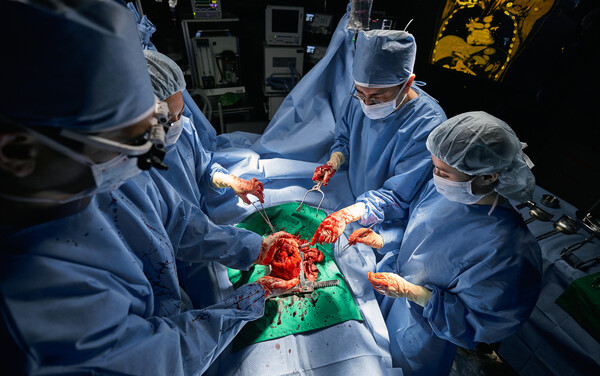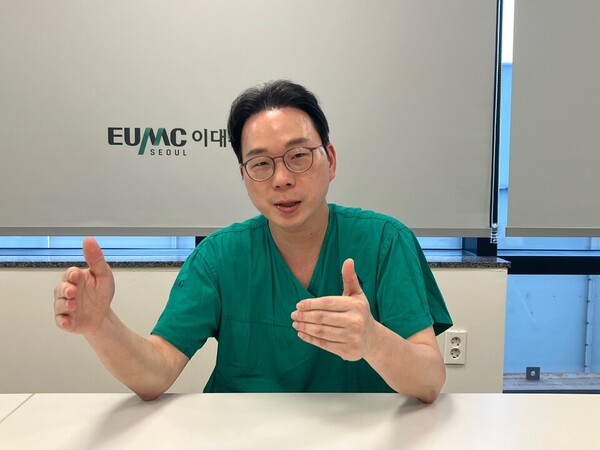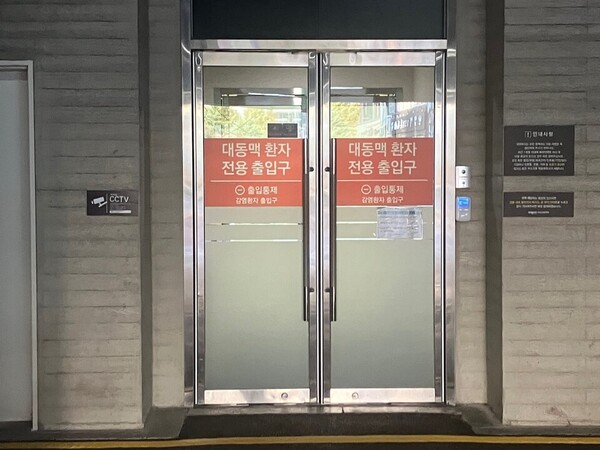An aortic dissection is a bomb in your body that could explode at any moment.
This ultra-urgent condition has no golden hour and can lead to instant death. Only immediate treatment can save the patient.

To narrow the gap of a minute between life and death, one hospital has gone “all-in” on surgery for patients with aortic disease. That institution is Ewha Womans University Aorta & Vascular Hospital, established in June last year within Ewha Womans University Medical Center (EUMC) Seoul.
It is the first university hospital in Korea to specialize in aortic treatment. Professor Song Suk-won of the Cardiovascular and Thoracic Surgery Department at EUMC Seoul heads it.
Professor Song is the doctor who performs the most aortic surgeries in Korea. As of last year, he performed more than 800 cases. That’s roughly two patients a day, every day of the year.
The results are also excellent. Professor Song has reduced the 20 percent aorta-related surgical mortality rate to 2-7 percent, raising the level of aortic disease treatment in Korea to world-class status. Recently, the hospital also set a new record for aortic surgery.
Last month, one year and three months after opening its doors, Ewha Womans University Aorta & Vascular Hospital surpassed 1,000 aortic surgeries, setting a domestic record. As the number of hospitals that can perform aortic surgery has decreased due to ongoing medical crises, patients are flocking to this new specialized hospital that can perform the surgery.
As a “scalpel-wielding doctor,” Professor Song's “zero priority” is to operate on patients with aortic disease. This interview also started a little later than scheduled because he was operating on an aortic dissection patient.
“I just finished the surgery,” he said, breathing heavily as he sat down in his scrubs. After pulling a few all-nighters and leaving work at 9 p.m. the day before, he explained that the milestone of 1,000 aortic surgeries was the result of “the hard work of the members of the Ewha Womans University Aorta & Vascular Hospital over the past 15 months.”
'Three' secrets to the success of Ewha Womans University Aorta & Vascular Hospital

Professor Song cited three keys to success.
They are the EXPRESS (Ewha Xtraordinary PREcision Safe Aortic Surgery) System, based on strong teamwork, medical resources, and an environment dedicated to treating patients with aortic disease, and the strong leadership of Dr. Yoo Kyung-ha, president of Ewha Womans University Medical Center.
In addition to the medical staff, including Professor Nam Sang-beom of the Department of Anesthesiology and Pain, Professor Lee Kwang-hun of the Department of Radiology, cardiovascular surgery nurses, extracorporeal circulators, intensive care unit nurses, and ward nurses, the staff of the administrative department, general affairs department, and security company also work as a team to operate the EXPRESS System.
The hospital built a “dedicated aortic patient entrance” so that all patients can go directly to the operating room when they arrive, rather than the emergency room, eliminating time spent in the emergency room and minimizing travel time. Administrative time is also saved by pre-registering patients before they arrive so they can be treated immediately. More than 120 people have joined the chat room to communicate like cogs in a wheel.
Together, they created a 24/7 hotline, which powers the EXPRESS System for emergency surgery and treatment. The system has reduced the time from arrival at the hospital to the operating room to four minutes.
“When other hospitals ask us to transfer patients, the patients are registered, and patient unit numbers are given before they arrive at our hospital. No matter how short the stay in the ER, it can take anywhere from 30 minutes to two hours. However, because we created a dedicated aisle for aortic patients, we can get them into the operating room in four minutes. This could never be done without consent from other departments. It's entirely a team effort,” he said.
However, even within the EUMC Seoul, there were initial doubts about the feasibility of a dedicated aortic treatment center in Korea. But doubts soon turned to confidence in its success. Ewha Womans University Aortic & Vascular Hospital has dramatically reduced the operative mortality rate to 2 percent for acute aortic dissection and 7 percent for prospective Acute Aortic Dissection. This is among the best in the world, given the 10-20 percent operative mortality rate globally. EUMC President Yoo's leadership also played a crucial role.
“When we declared that we would do emergency aortic surgery, Dr. Yoo gave us a lot of authority. She made the operating room a hybrid room and added a lot of medical staff, especially one room reserved for emergency patients. No other hospital in the world can do that. You need to have high OR turnover to increase your revenue, and you don't want to leave an OR unoccupied for an emergency patient who could come in at any time. We took bold action on those things.”
He recalls an incident last September when two patients with acute aortic dissections came in at the same time.
“We had two patients with acute aortic dissections at the same time. The distances were similar. The abdominal aortic rupture patient arrived at 12:20 am, and the acute aortic dissection patient arrived at 12:25 am. Most of the aortic dissection patients were unstable, but the abdominal aortic rupture couldn't wait, so they operated on it first, followed by the aortic dissection patient. The first patient arrived at 12:20. It took four minutes to get to the emergency room, and it was 1 a.m. by the time we finished operating on two patients.”

Full government support is needed; the hospital aims to train more aortic vascular specialists
Behind the life-saving and excellent surgical outcomes for emergency patients, there is also a financial burden due to “deficits.” It is only thanks to the full support of the EUMC that Ewha Womans University Aortic & Hospital can leave operating rooms vacant and deploy large-scale manpower despite low financial rewards for such operations.
However, without government support, it is difficult for a private hospital to sustain a structure that does not turn a profit. This proves that full financial investment is necessary to create a “medical environment where all citizens, no matter where they live or what kind of illness they suffer from, can be treated with peace of mind,” as President Yoon Suk Yeol said.
“The government is implementing a network of experts beyond medical institutions for emergency cardiovascular diseases, such as aortic dissection, but it is not working properly. Only about six cases a year have been transferred through the network, but money continues to flow to participating hospitals,” Professor Song pointed out.
“The government wants to equalize the whole country, but aortic dissection is less prevalent, and there are not many places to perform (surgery). The more cases you have, the better the outcome, but rural areas have fewer patients, so even if you want to gain experience, it's impossible. You should not try to equalize something that can't be equalized in the first place,” he said. ”For aortic vascular emergencies, which are not prevalent, we need to focus on what we can do well rather than spread our resources evenly.”
He also presented a blueprint for an aortic vascular hospital. He wants it to become a national hospital that not only performs surgery but also trains doctors who want to be specialists in aortic surgery.
Related articles
- TAVI reduces medical cost significantly in Korean healthcare system, experts say
- [APAC Heart Summit 2024] Why women's heart health is overlooked and what can be done
- Asan Medical Center sets Asian record in aortic valve stenting procedures
- Experts call for reform to integrate innovative medical technologies in Korea
- Emergency medicine society criticizes government for misleading cause of ER congestion
- Korea to build ICT-based electronic ICU in 2 regions next year

